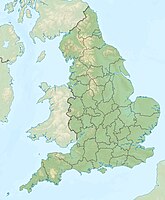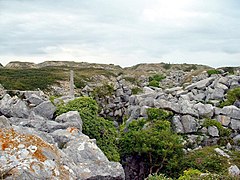Isle of Portland
| Isle of Portland | ||
 Map of the British Land Survey from 1960 at a scale of 1: 63360 |
||
| Geographical location | ||
|
|
||
| Coordinates | 50 ° 32 '39 " N , 2 ° 26' 12" W | |
| Waters 1 | English Channel | |
| length | 6.4 km | |
| width | 2.4 km | |
| surface | 11.5 km² | |
The Isle of Portland is a 6.4 km long and 1.5 miles wide limestone cliff in the English Channel . It is located near Weymouth in Dorset and is part of the Weymouth and Portland County . This county has a population of 65,076 people (as of 2011), of which 52,232 people are in Weymouth (as of 2011) and Portland 12,844 people (as of 2011). The former island is now connected to the mainland via Chesil Beach , a narrow, natural land bridge and is therefore now de facto a peninsula . It is also connected to Weymouth by a road bridge on the A354. As part of theJurassic Coast , the Isle of Portland, like this entire section of the English south coast, is a World Heritage Site.
There are several locations on the Isle of Portland. The largest are Fortuneswell and Easton. Other localities are Weston, Southwell, Castletown and Grove.
history
Portland has been inhabited since at least the Mesolithic. There is strong evidence that people then settled in Portland Bill, the southernmost point of the island. The Romans are said to have named the island Vindilis ; however, there is no written evidence for this. The writer Thomas Hardy called Portland in one of his books " Isle of Slingers" . In ancient times, the islanders were known to be masters of slingshots. In the Anglo-Saxon Chronicle , Portland is recorded in 787 as the place where the Vikings made their first foray into England (before Lindisfarne).
King Henry VIII had Portland Castle built in 1539 to repel attacks by the French. The cost of building it was £ 4,964 . Portland Castle is considered to be one of the best preserved forts of that time period and is now open to tourists.
In the Domesday Book , the island is recorded as “the King's possession”. Most of the quarries that made Portland famous were also owned by the Crown. In addition to the light color, the special feature of the rock is the “oolithic structure” . It arises in warm, lime-saturated shallow water with an even wave movement. Lime is deposited in concentric layers around a crystallization nucleus (e.g. a grain of sand) and, similar to a pearl , creates a spherical ooid . If many of these spheres are then solidified into a rock, an “oolithic limestone” is created.
After the Great Fire of London , Christopher Wren used six million tons of Portland limestone to rebuild the city. Well-known buildings that were built with this stone include St Paul's Cathedral in London and the UN headquarters in New York. After the First World War, a quarry was opened, which supplied rock for the London cenotaph and half a million gravestones. Portland limestone is still used today to renovate famous buildings; a current example is the British Museum . The Portland cement was named after their colorful resemblance to the Portland limestone.
Portland Harbor is the largest man-made port in the world with an area of 9 km². Prince Albert laid the foundation stone in 1849 . In 1872, Edward, Prince of Wales (later King Edward VII) put the last stone of the first phase of construction. The breakwaters were built by private construction companies, but all the stones were broken out by prisoners. 22 men lost their lives during construction. The breakwaters are made of 5,731,376 tons of stone.
There were frequent ship accidents off the island . On September 11, 1877, the Bark Avalanche collided with the Forest . Both ships sank; 106 people died. On April 15, 1918, the steamer Pomeranian was sunk by a German submarine, 55 people were killed.
On July 16, 1914, the British Home Fleet with 460 ships was assembled here and held maneuvers off the island. The suspension of the trial mobilization scheduled for July 26th has been postponed. The First World War began on July 28, 1914. During the Second World War, a large part of the Royal Navy was stationed on the island and in the port . Because of this, Portland has been the target of frequent air strikes. On June 16, 1950, there was an accident in the port. The Royal Navy's Sidon submarine was badly damaged by a torpedo explosion. 13 crew members were killed.
After the end of the Cold War , the naval base was closed and the Royal Air Force base was closed in 1998. A prison and a juvenile correctional facility still exist on the island. From 1997 to 2006 the only British prison ship, the HMP Weare , was here . Today the port is operated by the private company Portland Port .
At the southern end of the harbor, the Weymouth and Portland National Sailing Academy , the national sailing center , was built at the beginning of the 21st century . The sailing competitions of the 2012 Summer Olympics took place here. Portland and Weymouth are considered the best sailing waters in Europe.
At the south end of the island, Portland Bill, is the Portland Bill Lighthouse , which has been fully computer controlled since 1996. The earlier lighthouses are a little inland. One of them is now an important bird watching center.
The island is known in the British climbing scene for its numerous and well-secured sport climbing routes.
Language taboo rabbit
Rabbits have been harbingers of bad luck on Portland for more than a hundred years . A language taboo established itself in that these animals are not named with the word rabbit , but with the expressions underground mutton ("underground mutton"), furry things (" furry things ") or bunny (" rabbit") . The fear of using the word seems to go back to the workers in the quarries there. Since the rabbits left their burrow before a rock fall, they were seen as harbingers of bad luck for the sometimes fatal rock falls. In addition, a crane driver was killed 100 years ago when the ground gave way because of the numerous rabbit holes. As soon as the animals were seen in the quarries, the workers stopped working until "safety was restored".
The language taboo became known nationwide in Great Britain in October 2005. The media reported that the film Wallace & Gromit - On the Hunt for the Giant Rabbit (Original title: Wallace & Gromit: The Curse of the Were-Rabbit ) on posters in Portland out of respect for the local "superstition" with the slogan Something bunny is going on was advertised.
Portland sheep
The peninsula is the place of origin of the Portland sheep , a small, very frugal breed of sheep known for its tasty meat. On the peninsula, this breed was able to develop undisturbed for centuries. However, due to the limestone quarrying on the island, the number of sheep kept declined and the last herd kept on the peninsula was sold in 1913. The survival of the breed, which is still considered endangered, has been secured by the Rare Breeds Survival Trust .
gallery
1)… photographed from the hill above Fortuneswell, the largest of eight Portland villages. Portland Harbor is on the right.
2) ... seen from Abbotsbury Castle, a hill fortress from the Iron Age . It is located in a north-westerly direction about 18 kilometers from the port.
3) ... which were left open. After the end of the dismantling, this became a much-visited sculpture park.
4) ... from 1906 replaced the beacons housed in two towers.
5) ... and Higher Lighthouse (Upper Tower, in the background) - predecessor buildings of today's lighthouse. The bird watching center has been housed in the lower tower since 1961.
6) ... made of oolithic limestone with its typical, spherical structure. Here at the grave of the former chief gunner of Portland Castle, William York, who died in 1796 , in the churchyard of St. Georges.
See also
Web links
- Weymouth & Portland Borough Council (English)
- History of Portland (English)
- Portland Sculpture & Quarry Trust (English)
- Dr Ian West's Dorset Geology pages (English)
- Portland Castle (English)
Individual evidence
- ↑ Weymouth population . Dorset County Council. 2013. Retrieved July 11, 2013.
- ^ Population of Portland . Dorset County Council. 2013. Retrieved July 11, 2013.
- ↑ BBC Dorset: Portland's Prison Ship
- ↑ a b c Simon de Bruxelles: Wallace and Gromit film cursed by a furry animal. In: Times online. Times Newspapers Ltd., October 7, 2005, accessed June 30, 2009 . (Page no longer accessible, May 4, 2012)
- ^ A b c Wallace and Gromit spook island. British Broadcasting Corporation , October 7, 2005, accessed June 30, 2009 .
- ↑ Rabbits, the Portland taboo word. Weymouth and Portland Borough Council, accessed June 30, 2009 . (Page no longer accessible, May 4, 2012)
- ^ Philip Walling: Counting Sheep - A Celebration of the Pastoral Heritage of Britain . Profile Books, London 2014, ISBN 978-1-84765-803-6 , pp. 11 to 16







